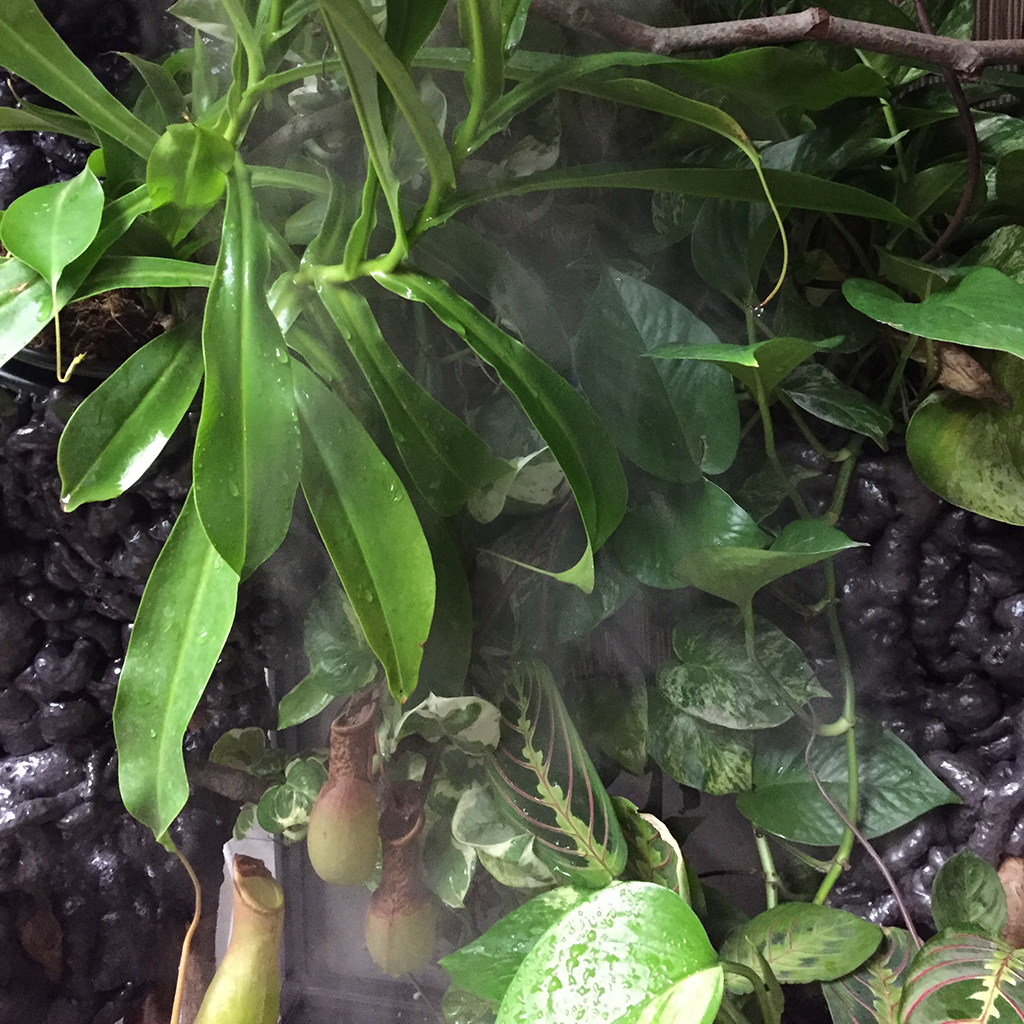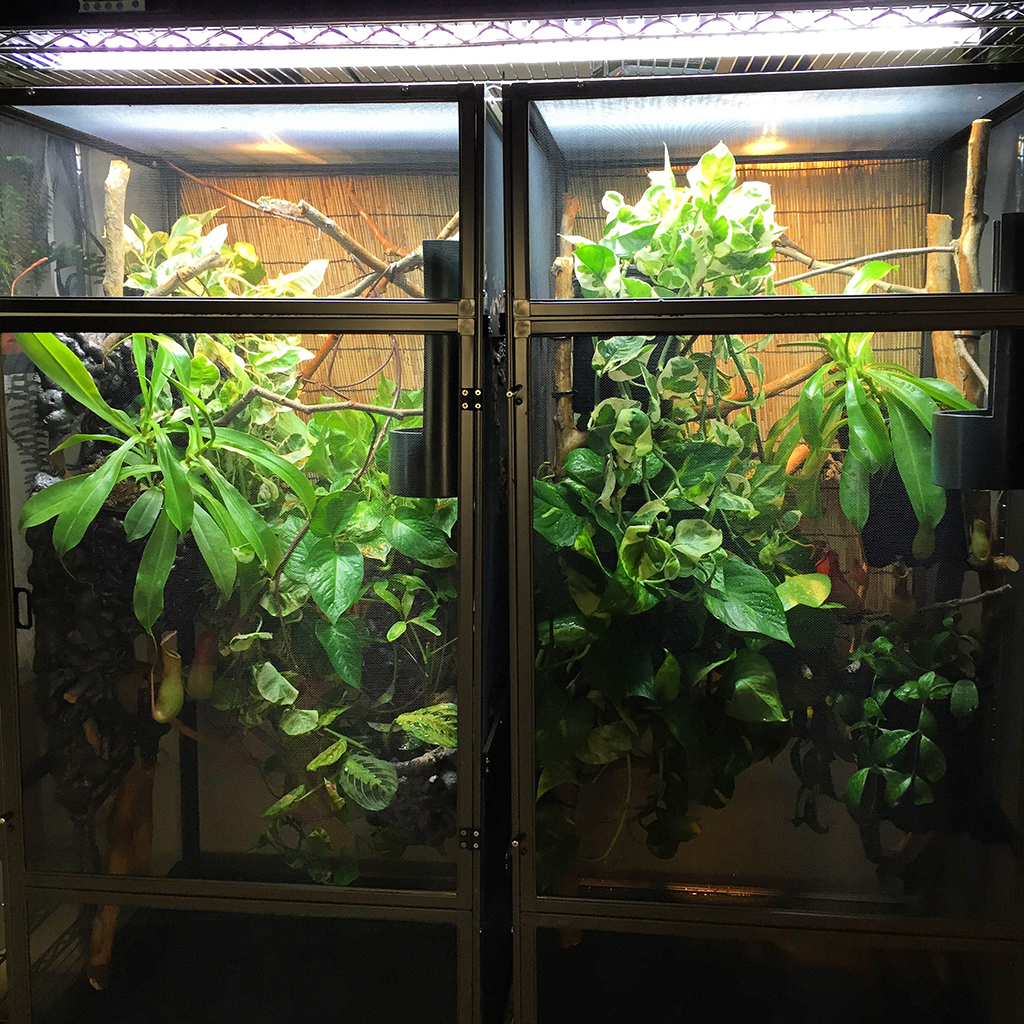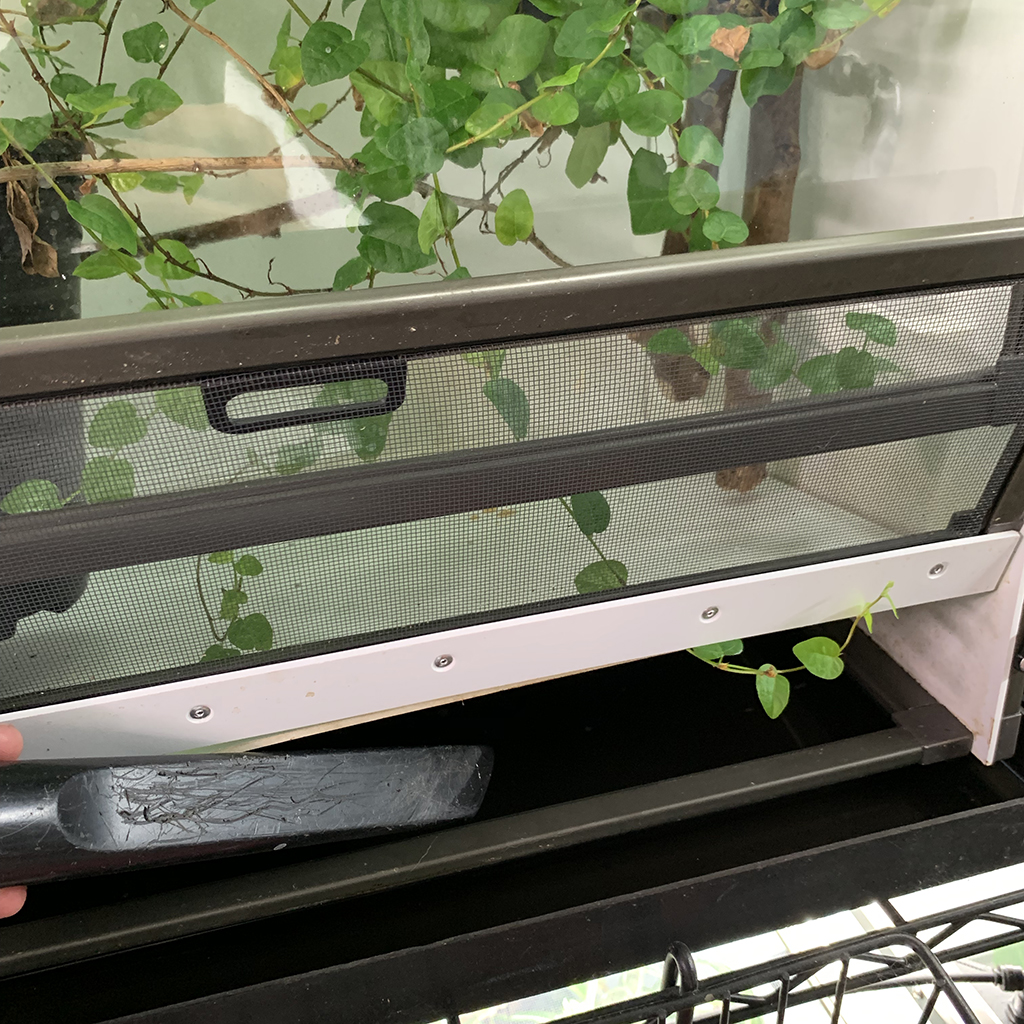Summary: Keeping Plants Alive
- Plants are living and require an environment themselves
- Plants need light and water
- When plants are happy it is a great sign that the environment is healthy
A vibrant vivarium is a joy to view and work with. It gives the feeling of life which only heightens the joy that keeping a chameleon can bring. But plants are living things as well and require attention. Luckily, they do not require a lot of attention and even people who struggle to keep plants alive can have a lush chameleon cage with attention to a few specific parameters. Water and light. Plants are simple in what they need!
Giving Plants Enough Water
One of the most common reasons for plant death in a chameleon cage is lack of water. We spend so much attention towards getting dew on the leaves that we do not think about getting the water to the soil. It is counter intuitive for us to see a pothos with dew laden leaves every morning and realize it is dying from lack of water. Maintenance of plants includes checking the soil moisture every week. Most of our houseplants enjoy a soak and then being allowed to dry out a little. I have found success with most of the house plants of squirting some water on their soil once or twice a week depending how quickly they lose water. Although you have to always make sure the soil has the moisture it needs, it is amazing what happens when you create a natural hydration cycle on your cage with nighttime fogging. The plants respond dramatically.
If your plants are dying check the soil of the ones that are passing away. Is it dry? If so then that is either the answer or one of the problems.
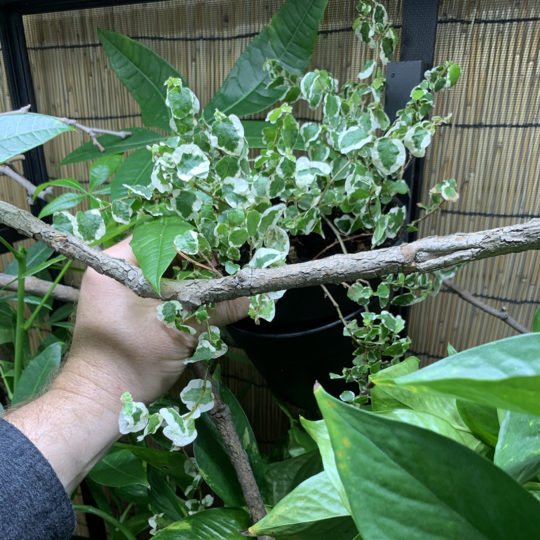
Ficus pumila, the creeping fig, is a wonderful vivarium plant which can easily spread and cover surfaces with green or, in this case, variegated leaves. But they dry easily and if not kept hydrated will go downhill quickly. This is a specimen being placed in a cage at the beginning.
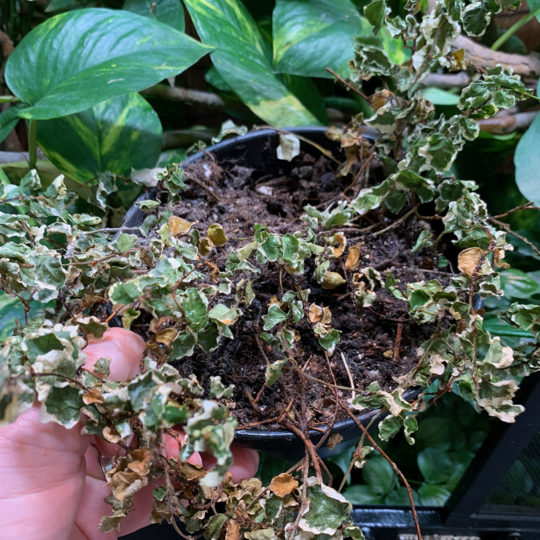
As it was in back it was in an area that did not get watered and I did not set up an appropriate watering schedule and so the plant dehydrated. Many waxy leaf plants can hang on and give you plenty of warning. Ficus pumila does not have this protection and, when going downhill, will go quickly. This is the advantage to the double pot method. I was able to easily remove this plant, put it in rehabilitation, and put in a replacement.
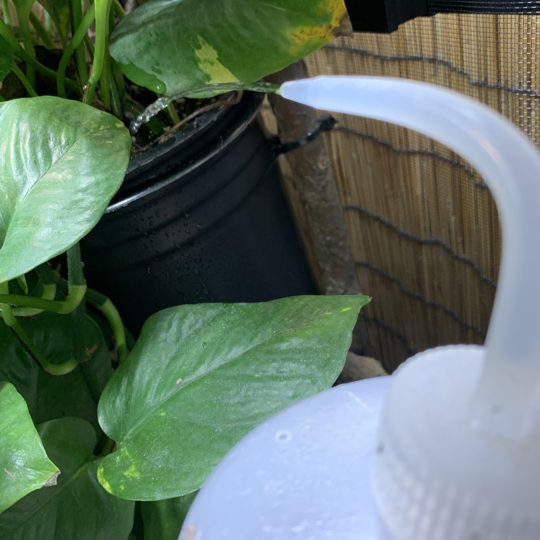
Standard water gardening cans or even drippers dripping into the plant from above can be used to get water to the plant. Though, many times, we chameleon keepers are not able to easily reach the plants that are inside the cage in back. To reach the plants in back I have a collection of water squirt bottles which allows me to hit the pot from a foot away. And that works perfectly for me!
I have found the 1000 mL bottles are the best buy. And, yes, having three is better than one! I have a bottle sitting at the different cages.
Giving Plants Enough Light
Chameleon cages have traditionally suffered from being little more than cages. Luckily, new lighting technologies (T5 and LED lighting namely) have made it much easier to flood our cages with light. But if your plants are stringy and look like they are stretching for the light that is exactly what they are doing. This is definitely an issue if your lighting is on top of your cage and the plants are at the bottom. The chameleon lives where the light is bright, but the plants are not able to move to the light besides doing the sad stretch. The solution, of course, is to get more light to the plant. Either bring the plant up or bring more light down.
Light can also be blocked by the growth of plants. In the example to the right, this Prayer Plant (Maranta leuconeura var.erythroneura) is at the bottom of the plant chain. While it got light when first set up, the plants above have since grown and blocked light from getting down below. In this case either the plants above need to be trimmed back or the bottom plant replaced with another that can handle lower light conditions. I, personally, am experimenting with placing another light to shine from outside the cage to allow a beautiful thick foliage the height of the cage.
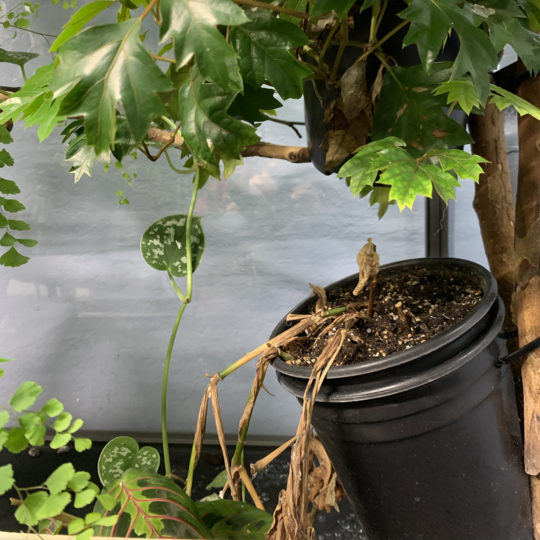
Saving a Dried Out Plant
If a plant gets dried out there is still hope. Remove the plant and soak it for 24 hours in a container of water. After that place the plant in bright light and repeat the soak every weekend. See if you can bring back your plant!
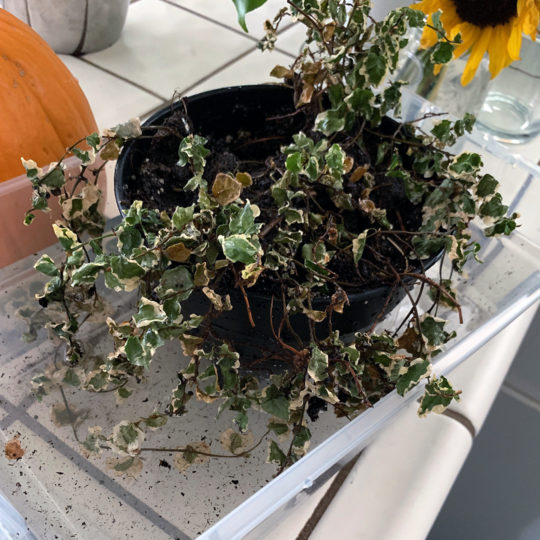
My Chameleon is Eating My Leaves!
So you have enough to deal with getting rid of your black thumb and your chameleon decides to start chomping on your plants! Really? Is the universe plotting against you?
There is a very high probability that the chameleon in question is a Veiled Chameleon. This species is known for taking bites out of plants. In its native Yemen, eating leaves gives the Veiled Chameleon roughage to help pass the poop made by eating soft caterpillars. Although it no longer needs this due to the captive diet of insects with exoskeletons, instinct still drives them to take bites out of your prize Golden Pothos.
There is nothing to be done and nothing to worry about. Both the chameleon and the plant will be fine. You just have a very unique plant leave to decorate your cage!

Trimming Plants
There are very few house plants available to us that will not out grow the cage under the right conditions. Ficus benjamina can grow to 40 feet and higher while Schefflera arboricola can grow merely 25 feet tall. Even our favorite Pothos will grow to 40 feet long in proper conditions. So pruning is a necessity when you do it right. The problem you will run into first is one plant growing to hit the ceiling and disfiguring as it tries to break free. And then there will be the one expanding enough to block the light for the other plants which leaves you with a cage that has only one living plant. Therefore, do not be shy about pruning. Just be careful for the plants that have a sap. I like to do my pruning a couple times a year either by flashlight after my chameleon has gone to sleep (so any sap can dry before morning) or else in Spring time when my chameleon can go visit the outside world for some natural sunlight.
This China Doll has reached the height limit and needs to be cut back.
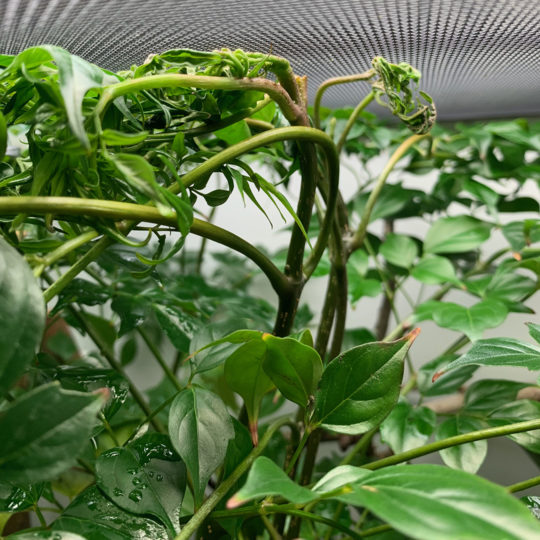
Navigation
This seminar is part of the introductory course Maintaining Your Chameleon Cage which, in turn, is a module within the even larger Term 1: Getting Started With Chameleons. Here we got ready to keep not only the chameleon, the entire environment. In the next module, we will look at cleaning the cage.

